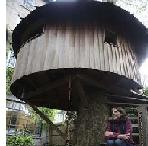Treehouse
Greenwich Village woman gets to keep backyard treehouse
 In the countryside, in the suburbs or even in the leafier districts of New York's outer boroughs, a treehouse would hardly raise an eyebrow. But in a historic Manhattan neighborhood whose residents have included Mark Twain and Eleanor Roosevelt, it raised hackles.
In the countryside, in the suburbs or even in the leafier districts of New York's outer boroughs, a treehouse would hardly raise an eyebrow. But in a historic Manhattan neighborhood whose residents have included Mark Twain and Eleanor Roosevelt, it raised hackles.
Shortly after Melinda Hackett put up the round, cedar treehouse for her girls in a broad-trunked London Plane tree in her tiny Greenwich Village backyard, a neighbor called about "a structure in rear which is nailed to a tree" and "looks unsafe," with no construction permit posted, according to a complaint filed with the city.
"I got home and the police were at the door," says Hackett, a 49-year-old artist. "Then firefighters came."
After months of legal battles, Hackett triumphed. Her girls' treehouse, apparently unique in one of America's most densely populated areas, can not only stay — it's been granted landmark status.
Though the treehouse is only five years old, Hackett's townhouse is from the 1860s, and she bought it from musician David Byrne of the Talking Heads. The city's Landmarks Perservation Commission decided to grant the treehouse a permit because it's part of a historic landmark district.
Any addition or change on such property requires approval with a permit, and architect Robert Strong filed Hackett's structure under "recreation equipment" allowed in a backyard, according to a city zoning resolution.
It was all much more trouble than Hackett imagined when she moved to Greenwich Village in 2005 from rural upstate New York.
A single mother of three girls, ages 11, 13 and 16, the artist got the idea for her urban respite from a friend who knew two carpenters who had built one on Shelter Island, just off Long Island.
"She said, 'You should have one on your big tree!'" Hackett says.
She decided to spend $5,000 to make up for the freewheeling existence her children had lost in North Salem, 50 miles from New York City.
"I came from the country with three little girls who were used to running around," their mother says. "I wanted them to have an oasis of calm in the city, a private space."
The treehouse was started months after she bought the property on West 12th Street from Byrne, a decade-long resident. In the backyard stands the proud London Plane, stretching high into the sky above the four-story townhouse beneath it.
Carpenters Nick Cohen and Ashley Koral worked on the project on and off for about five months.
"I just told them I like circular things," says Hackett, whose art is filled with circles in vivid colors.
Her ground-floor painting studio has a view of the treehouse — and of a swing made from old firewood that hangs from a branch, next to a bird feeder that attracts cardinals, blue jays and doves.
"It's a beautiful treehouse; it has a beautiful design," says architect Robert Strong, who helped Hackett unravel the red tape threatening her treehouse. "It's wonderful the way it encompasses the branches; it's completely rounded, flowing much like the tree."
But Hackett's neighbor, who she says "didn't love that I had moved in here with two dogs and three kids," wasn't as appreciative.
Strong at first believed the Department of Buildings would not require a permit "because we couldn't find a niche for it in the building code," the architect says.
But after the anonymous complaint, Hackett was forced to defend herself before the city's Environmental Control Board court, where "none of the judges knew what to do with a treehouse," she says.
Hackett turned to Strong, who said he doesn't know of any other private treehouses in Manhattan — though plenty of houses in less dense areas of the city offer sizeable yards and towering trees suitable for treehouses.
"This is a very rare structure in an urban environment," Strong says.
At the top of a wooden staircase with a rope bannister, under a metal roof and about 10 feet off the ground, is the world Hackett's girls enjoy.
Archie comic books and a sketch pad are strewn around. An old cassette boombox sits on a rickety table near a few chairs and a furry pillow. There's also a copy of the children's book "The Daring Book for Girls," by Andrea J. Buchanan and Miriam Peskowitz.
On a piece of paper, a child wrote, "Be Very Afraid." On the curved walls are drawn handprints and scribbled words like "Ha ha." Branches of greenery poke through a few windows.
"My kids come up here and have meetings. They use it as a clubhouse," Hackett says. "They plot. They scheme. They gossip."
Another paper reads "No Trespassing." Hackett says she never goes up uninvited, but there are a few rules: "No smoking, no drinking, no swearing."
It took Hackett about six months to defend the right to keep the structure, and it cost about as much as the construction price to settle three violation notices from the Department of Buildings for erecting a structure in a protected district without a permit, plus architect's fees.
In New York, where legal codes address buildings with foundations, plumbing and other construction factors, the ECB judges in June 2006 "scratched their heads, and finally, the case was dismissed," Hackett says.
It was all worth it, she says: "This is the little treehouse that could."
(Published by NY Post – October 27, 2010)